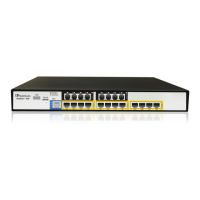Network connections - see 'Configuring Network Connections' on page 583
Before you begin configuring the data functionality, you should familiarize yourself with
working with the data-related configuration pages, as described in Getting Acquainted with
Data Configuration Pages on page 533.
Notes:
• Virtual Routing and Forwarding (VRF) can only be configured using the
device's CLI. This allows multiple instances of a routing table to co-exist
interfaces to be clustered into a VRF to provide segregated routing
domains. The VRF feature uses the device’s single physical router as
multiple logical routers (up to 32). Each VRF is associated with its own
routing table. When creating fully separated logical routers on the same
physical router, every interface can be mapped to a specified VRF and
static routes can be added to it. The main CLI command for configuring
VRF is ip vrf. Note: Some features are available only on the default,
unnamed, VRF. These include, amongst others, BGP, OSPF, RIP,
Management interfaces (Web, CLI and SNMP), and SIP (when using the
device’s VoIP component). For a complete list of features supported only
on the default VRF, please contact AudioCodes. For a detailed
description of CLI configuration, refer to the MSBR Series CLI Reference
Guide.
• IPSec tunneling can only be configured using the device's CLI. This is
configured using the crypto CLI commands. For a detailed description of
CLI configuration, refer to the MSBR Series CLI Reference Guide.
• To enable Power over Ethernet (PoE) status indication (for example,
when an IP phone is connected to one of the device’s LAN ports), use
the CLI command, GetPOEPortStatusCmd.
• The device supports the monitoring of traffic traversing its LAN ports (i.e.,
Port Mirroring). This includes monitoring of egress and/or ingress traffic.
This feature is useful for analyzing traffic or debugging network
problems. The CLI commands, port monitor and show data port-
monitoring are used for displaying this information.

